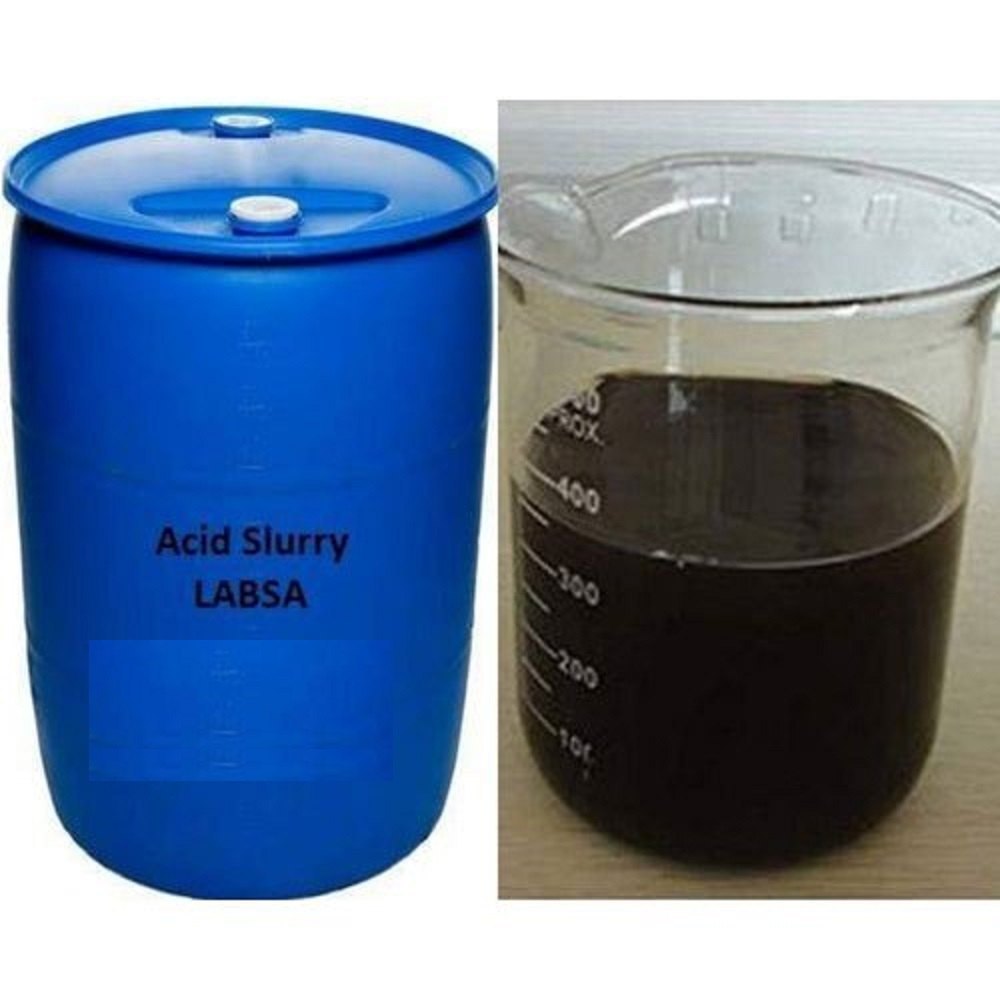Acid slurry, also known as Linear Alkyl Benzene Sulfonic Acid (LABSA), is a key component in many household and industrial cleaning products. Its powerful cleaning properties and versatility make it an essential ingredient in detergents, soaps, and other cleaning agents. In this blog, we will explore what acid slurry is, its production process, applications, benefits, and the environmental considerations associated with its use.
What is Acid Slurry?
Acid slurry is a sulfonic acid derivative of linear alkyl benzene (LAB). It is an anionic surfactant, meaning it carries a negative charge that helps in the emulsification and breakdown of oils and fats. LABSA is widely used in the formulation of synthetic detergents and cleaning products due to its excellent detergent and cleaning properties.
Chemical Properties
- Chemical Formula: C₁₈H₂₉SO₃H
- Appearance: Brown viscous liquid
- Solubility: Highly soluble in water
- pH: Typically acidic, around 2-3
Production Process
The production of acid slurry involves the sulfonation of linear alkyl benzene (LAB) with sulfur trioxide (SO₃). The process can be summarized as follows:
- Preparation of LAB: Linear alkyl benzene is produced from the alkylation of benzene with long-chain olefins.
- Sulfonation: LAB is reacted with sulfur trioxide to produce LABSA. This reaction is typically carried out in a continuous sulfonation reactor.
- Neutralization: The resulting LABSA can be neutralized with an alkali (such as sodium hydroxide) to produce the corresponding sodium salt, commonly used in detergents.
Applications of Acid Slurry
Acid slurry is used in a wide range of cleaning products due to its excellent properties:
- Detergents: It is a primary ingredient in laundry detergents and dishwashing liquids, providing strong cleaning action and foaming properties.
- Soaps: Used in bar soaps and liquid hand washes to enhance cleaning efficiency and lather.
- Industrial Cleaners: Found in heavy-duty cleaning agents for industrial applications, such as degreasers and floor cleaners.
- Emulsifiers: Used in the formulation of emulsifiers for various applications, including textiles and agriculture.
- Household Cleaners: Present in all-purpose cleaners and surface cleaning products for effective removal of grease and dirt.
Benefits of Acid Slurry
- Effective Cleaning: Acid slurry is highly effective at breaking down oils, fats, and dirt, making it an excellent cleaning agent.
- Foaming Ability: It produces a rich and stable foam, enhancing the user experience in cleaning applications.
- Versatility: Suitable for use in a variety of products, from household cleaners to industrial detergents.
- Cost-Effective: It is relatively inexpensive to produce, helping to keep the cost of cleaning products affordable.
- Biodegradability: LABSA is biodegradable, reducing its environmental impact compared to some other surfactants.
Environmental and Safety Considerations
While acid slurry is widely used and generally considered safe, there are some environmental and safety considerations to be mindful of:
- Skin and Eye Irritation: Acid slurry can be irritating to the skin and eyes, especially in its concentrated form. Proper handling and use of personal protective equipment (PPE) are essential during manufacturing and formulation.
- Acidic Nature: The acidic nature of LABSA requires careful handling and appropriate neutralization in cleaning products to prevent irritation and corrosion.
- Water Pollution: Although LABSA is biodegradable, improper disposal and excessive use can contribute to water pollution. Ensuring proper wastewater treatment and responsible usage is important to minimize environmental impact.
Moving Towards Sustainable Practices
As environmental awareness increases, there is a growing emphasis on sustainable practices in the production and use of acid slurry. Manufacturers are focusing on:
- Green Chemistry: Developing more environmentally friendly production methods that reduce waste and emissions.
- Biodegradable Alternatives: Researching and using surfactants that are more readily biodegradable and less harmful to aquatic life.
- Waste Management: Implementing effective wastewater treatment and recycling processes to minimize environmental contamination.
Conclusion
Acid slurry, or Linear Alkyl Benzene Sulfonic Acid, is a vital ingredient in many cleaning products, valued for its powerful cleaning and foaming properties. While it offers numerous benefits in terms of effectiveness and cost-efficiency, it is important to handle and use it responsibly to mitigate any potential environmental and safety concerns. As the industry continues to evolve, sustainable practices and the development of greener alternatives will play a crucial role in ensuring that we can maintain cleanliness without compromising environmental health. Understanding the properties and impacts of acid slurry helps consumers and manufacturers make informed choices for a cleaner and safer future.

